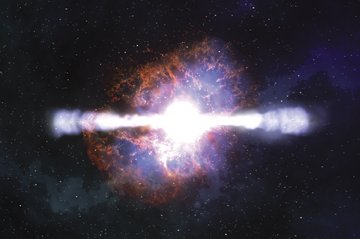To announce their arrival, black holes give off a birth cry—an energetic flash of light known as a gamma-ray burst. Now, astronomers have evidence that just minutes later, the newborns emit powerful X-ray burps as well.

NASA’s Swift spacecraft is the first to record these never-before-seen hiccups because it can slew its X-ray telescope to just the right patch of sky immediately after the craft detects a gamma-ray burst. One of the newly detected X-ray flares, recorded 12 minutes after a gamma-ray burst on May 2, packed about as much energy as the burst itself. David N. Burrows and Peter Mészáros of Pennsylvania State University in State College and 32 colleagues describe their findings in an upcoming Science.
The observations may illuminate the first minutes of a black hole’s life and suggest that massive stars often explode in a series of pyrotechnic events, rather than in a single blast. “Stars are exploding two, three, and sometimes four times in the first minutes following the initial explosion,” says Burrows.
According to a leading theory, most gamma-ray bursts arise when the core of a massive, rapidly rotating star collapses under its own weight. The collapsed core becomes a black hole, which shoots out jets of material at nearly the speed of light, hurling the star’s outer layers into space. Collisions between lumps of material in the jets generate the gamma-ray bursts, the most powerful explosions in the cosmos since the Big Bang.
After exiting the star, a jet slams into gas and dust in space. This collision generates an afterglow that may begin an hour or so after the burst and can last from hours to months. The glow begins with X rays and ends with radio waves.
The newly observed X-ray flares, which rise and fade rapidly, fill in what had been “a big blank” between an initial burst and the afterglow, says Mészáros. His team proposes that the X-ray hiccups may trace the early eating habits of the infant black holes. As a black hole swallows gas and dust, the doomed material emits a last gasp of high-energy radiation—the X-ray emissions that Swift detected.
Coauthor Stan Woosley of the University of California, Santa Cruz notes that a newborn black hole has an abundance of material on which to chow down. That’s because much of the gas and dust in the jets fails to escape the hole’s gravity, he says. “It goes out a ways and then falls back a few minutes later, reenergizing a new round of [eating] and jet production by the black hole.” There could be other explanations for the hiccups, cautions Mészáros. “It’s like we just entered a new toy store” and are still trying to figure out what’s there, he says.







